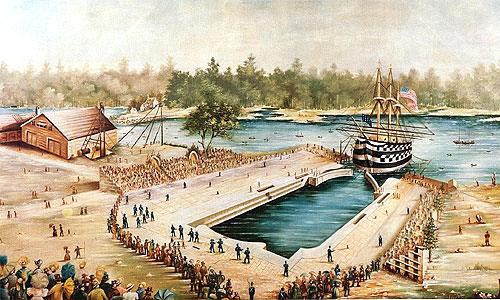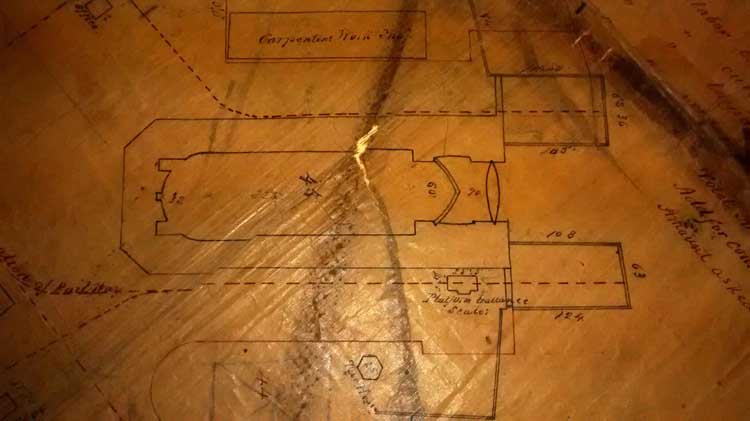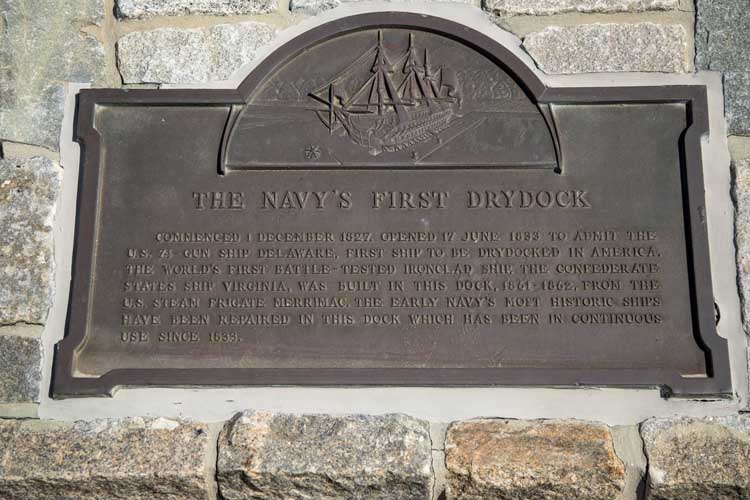
Marcus
W. Robbins, Historian & Archivist
Copyright. All rights
reserved.
Blog 67
The Stone Dock & The USS Delaware – 186 Years Ago
Timeless: The Stone Dock at Gosport.
Much has been written about Norfolk Naval Shipyard’s Dry Dock #1, but today on June 17, 2019, we should take pause to remember that upon this site 186 years ago naval history was made in the then young country of America. We successfully accomplished the very first dry-docking of a vessel in the America’s right here in Portsmouth, Virginia, on the shore of the Southern Branch of the Elizabeth River.
A little history: Why did we need a Dry Dock and exactly what does it do?
One must be aware that the concept of modern dry docking was indeed recognized by the Americans as our young Navy was born and grew as a means to efficiently effect under the waterline repairs to vessels yet the concept of placing a ship out of water and into a "dry dock" goes back to early Greco-Roman practices in the area of Egypt nearly 2,200 years ago. Over the last few centuries, the Europeans refined it to the practice we know today.
As with any Government program or new idea, several revisions and attempts to fund seem to be the normal course. With the construction of a dry dock to support the newly formed American Navy Department this was no different. I offer a summary here of dates and order of events found in "History of the United States Navy Yard at Gosport Virginia" (Lull 1874) lost to time and never published in any other contemporary writings but important when considering the whole. Several times from the inception of the Navy Department in 1798 twice, appropriations had been made to Congress for the construction of docks, (on the 25th of February 1799, and on the 3rd of March 1813) but the amounts appropriated were so small as to be entirely inadequate to the purpose.
On the 25th of May 1824, the Senate of the United States passed a resolution calling upon the Secretary of the Navy for information on the following points:
1st. The expediency, usefulness, economy, and necessity of a dry dock of sufficient capacity for receiving, examining, and repairing ships of the line.
2nd. The best location for a dry dock.
3rd. The probable expense of the construction of one of the size mentioned, in a solid and durable manner, with the needful appendages for an advantageous use of it.
The Honorable Mr. Southard, then Secretary of the Navy, in his answer to the resolution, under the date of January 3, 1825, urged in very strong terms the necessity not only of one but of at least two dry docks for the Navy at its then present size. He stated that the only method of examining and repairing the hulls of heavy ships below the waterline, then available, was that of heaving down, an exceedingly slow, expensive, laborious, and dangerous operation, and very unsatisfactory in its results; while, with a dry dock, work might be performed in a few hours, and at trifling expense, which would take weeks by the process then in use.
Our Drydock 1 can be attributed to the one of the young country’s finest civil engineers at the time, Colonel Loammi Baldwin Jr. Baldwin in his personal profession had made two different trips to Europe studying and examining public works, the last being in 1824. This coincided with a report of the Secretary of the Navy urging the building of two dry docks in America that was presented on May 25, 1825, thus the die was cast leading to his acceptance of an appointment to oversee the construction of the new dry docks at the Charlestown Navy Yard in Boston, Massachusetts, and the Gosport Navy Yard in Portsmouth, Virginia, between the years of 1827 and 1834.
Colonel Baldwin was one of a family of engineers, all more or less distinguished in their profession. He had visited many of the dry docks of Europe, and was particularly qualified for the work, which he afterward preformed of building the docks at Gosport and Charlestown (Lull 1874).
Gosport would soon benefit from legislation entitled "An Act for the Gradual Improvement of the Navy of the United States" passed on March 3, 1827. The shipyard would grow both to the West and more importantly to the South as additional land was purchased in order to create a place to construct the dock. A little known fact is that our Gosport dock was first planned to be placed just south of then Shiphouse "B", otherwise known as where the 350 Ton Hammerhead Crane sits today by a circa 1825 map that survives.
Thus the dock was constructed in the newly acquired southern lands and yet before its ultimate completion allowed the USS Delaware, a Ship of the Line rated at 74 guns to enter beating the Boston Navy Yard's docking of USS Constitution by one weeks’ time. Many contemporary images of the event have been published and are familiar to most and I include one with this story.

USS DELAWARE 1st Docking in North America June 17, 1833.
(public domain image)I also provide for you an extremely rare image of an 1858 station map, ink on linen, that somehow survived the two fires of Gosport that came after its creation and now rests safely within the collection of the Portsmouth Naval Shipyard Museum. It is with this map you can view previously un-documented construction sizes and unique location details of the cob wharf piers at Gosport’s famous Stone Dock as they were part of the whole support of our early shipyard. As a facilities person when I first had opportunity to view this map, it truly provided a "vision of the past" and was a personal "wow moment" in my career as current staff Historian of this shipyard.

Plan of Navy Yard Gosport Va. August 31st 1858.
(Courtesy of Portsmouth Naval Shipyard Museum)Therefore, in summary, 186 years without a major repair is a testament to the artisans of the time to build enduring facilities to support our nation’s Navy. As viewed at the head of the today’s Dry Dock #1, I conclude with an image of the historic bronze plaque as it sums up this facility's importance to America’s Shipyard perfectly starting with the USS Delaware docking because – "history matters"
Dry Dock #1 Plaque on April 14, 2014.
(Courtesy of US Navy)
